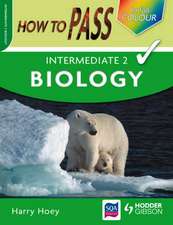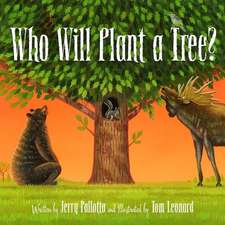The Acari: Reproduction, development and life-history strategies
Editat de Reinhart Schusteren Limba Engleză Paperback – 5 noi 2012
| Toate formatele și edițiile | Preț | Express |
|---|---|---|
| Paperback (1) | 404.67 lei 43-57 zile | |
| SPRINGER NETHERLANDS – 5 noi 2012 | 404.67 lei 43-57 zile | |
| Hardback (1) | 598.96 lei 43-57 zile | |
| – | 598.96 lei 43-57 zile |
Preț: 404.67 lei
Nou
Puncte Express: 607
Preț estimativ în valută:
77.43€ • 81.05$ • 64.45£
77.43€ • 81.05$ • 64.45£
Carte tipărită la comandă
Livrare economică 31 martie-14 aprilie
Preluare comenzi: 021 569.72.76
Specificații
ISBN-13: 9789401053747
ISBN-10: 940105374X
Pagini: 584
Ilustrații: XXIII, 554 p.
Dimensiuni: 155 x 235 x 31 mm
Greutate: 0.81 kg
Ediția:Softcover reprint of the original 1st ed. 1991
Editura: SPRINGER NETHERLANDS
Colecția Springer
Locul publicării:Dordrecht, Netherlands
ISBN-10: 940105374X
Pagini: 584
Ilustrații: XXIII, 554 p.
Dimensiuni: 155 x 235 x 31 mm
Greutate: 0.81 kg
Ediția:Softcover reprint of the original 1st ed. 1991
Editura: SPRINGER NETHERLANDS
Colecția Springer
Locul publicării:Dordrecht, Netherlands
Public țintă
ResearchCuprins
One Life-history Strategies.- 1 The life strategies of mites.- 2 Life-history evolution of spider mites.- 3 Life-cycle strategies in unpredictably varying environments: genetic adaptations in a colonizing mite.- 4 The evolutionary transformation of osmotic regulation in the life cycle of freshwater mites (Hydrachnidia).- 5 Development and life-history strategies in mussel mites (Hydrachnellae: Unionicolidae).- Two Reproduction.- 6 Spermatology in the Acari: systematic and functional implications.- 7 The distribution, mechanisms and evolutionary significance of parthenogenesis in oribatid mites.- 8 Indirect sperm transfer in prostigmatic mites from a phylogenetic viewpoint.- 9 Spermatophore deposition in relation to atmospheric humidity among terrestrial Parasitengonae (Prostigmata).- 10 The role of Adlerocystis sp. in the reproduction of argasid ticks.- 11 A scanning electron-microscopy study of spermatogenesis in Pergamasus barbarus Berl. (Gamasida.- 12 Precise sex-ratio control in the pseudo-arrhenotokous phytoseiid mite, Typhlodromus occidentalis Nesbitt.- 13 Sex ratio, fitness and capacity for population increase in Pyemotes tritici (L.-F. and M.) (Pyemotidae).- 14 Preliminary observations of ovoviviparity in the gallforming mite, Aceria caulobius (Nal.) (Eriophyidea: Eriophyidae).- 15 Laboratory observations on duration of copulation and egg production of three phytoseiid species fed on pollen.- 16 Precopulatory mate guarding in the spider mite, Tetranychus cinnabarinus (Boisd.) (Tetranychidae).- Three Diapause, Development and Trophic Relations.- 17 Physiological aspects of diapause in plant-inhabiting mites.- 18 Repeated induction and termination of diapause in the predacious mite, Amblyseius potentillae (Garman) (Phytoseiidae).- 19 Inheritance of photoperiodic responses controlling diapause in the two-spotted spider mite, Tetranychus urticae Koch.- 20 Some observations on diapause in winter eggs of Panonychus ulmi (Koch) (Tetranychidae).- 21 Reproduction, embryonic and postembryonic development of Trichouropoda obscurasimilis Hirschmann and Zirngiebl-Nicol 1961 (Anactinotrichida: Uropodina).- 22 Resource allocation and utilization contrasts in Hypoaspis aculeifer (Can.) and Alliphis halleri (G. and R. Can.) (Mesostigmata) with emphasis on food source.- 23 The influence of different host plants on the reproductive potential of Tyrophagus putrescentiae (Schrank) and Tyrophagus neiswanderi Johnston and Bruce (Acaridae).- 24 The relationship between house-dust mites and fungi.- 25 How plants maintain body-guards: plant exudate as a food source for phytoseiid mites.- Four Systematic, Morphology, Physiology and Behaviour.- 26 Distribution of characters and phylogenetic age — systematic problems in the higher taxa of the Oribatida.- 27 A new approach to the systematics of the genus Steganacarus (Oribatida).- 28 The morphology of the immature stages of Phthiracaroidea (Oribatida).- 29 A new interpretation of the epimeral theory of Grandjean.- 30 A comparison of the sclerotized parts of the reproductive organs of house-dust mites of the genus Dermatophagoides using scanning electron microscopy.- 31 Reproductive systems in Acaridida — some peculiar features.- 32 A respiratory apparatus in eggs of certain mites.- 33 Fine structure and functions of the mouthparts involved in the feeding mechanisms in Cenopalpus pulcher (Canestrini and Fanzago) (Tetranychoidea: Tenuipalpidae).- 34 The alveolar salivary glands of the active phases of trombiculid mites (Trombiculidae).- 35 Pigmentation in water mites of the genera Limnochares Latr. andHydrodroma Koch (Hydrachnidia).- 36 Biomass studies of water mites of the genera Limnochares Latr. and Hydrodroma Koch (Hydrachnidia).- 37 The saltatory capacity of an oribatid mite.- 38 Thanatosis or feigning death in mites of the family Scutacaridae.- Five Field Studies and Applied Aspects.- 39 The effects of spider-mite feeding on plant performance in relation to biological control.- 40 Dispersion indices and constant precision sampling programmes for Panonychus ulmi (Koch) and Amblyseius andersoni (Chant) in Spanish apple orchards.- 41 Herbicides and the reproduction of Tetranychus urticae Koch.- 42 Phytoseiid mites associated with vines in Sicilian vineyards.- 43 Studies on mites associated with lucerne in Greece.- 44 Vertical distribution and life stages of oribatid communities on beech trees.- 45 Histiostoma murchiei Hughes and Jackson (Anoetidae) as a parasite in the cocoons of some Danish earthworms.- 46 Rearing deutonymphs of Iphidosoma fimetarium (J. Müller), a mesostigmatic mite associated with carabid beetles.- 47 Mites of the House mouse, Mus musculus L., in the north-eastern part of the Iberian Peninsula in Spain.- 48 Records of Ixodoidea from the Trentino-Alto Adige region in northern Italy.- 49 Seasonal and spatial variation in food intake by the oribatid mites of beech woodland soil.- 50 The effects of ploughing and rotary cultivation on soil mites with particular reference to the Mesostigmata.- 51 The influence of soil cultivation methods on the edaphic fauna, and especially the Gamasina (Mesostigmata), in two southern German vineyards with different cultural treatments.- 52 The density of Tarsonemida in cropped arable soil in relation to fertilizer and crop-protection treatments.- 53 Soil mites and acidification: a comparative study of four foreststands near Heidelberg.- 54 Reactions of mite populations to the influence of environmental chemicals in a beech-wood floor.- 55 Population studies on the house-dust mite. Euroglyphus maynei (Cooreman 1950) (Pyroglyphidae).- 56 Management of mite development in the home.- 57 An indirect effect of cleaning on house-dust mites. (Dermatophagoides spp.) in carpets.- 58 Astigmatic and prostigmatic mites of grain stores, mills and sawmills in Finland.- Index to plant genera and species.- Index to animal genera and species.- Author index.




